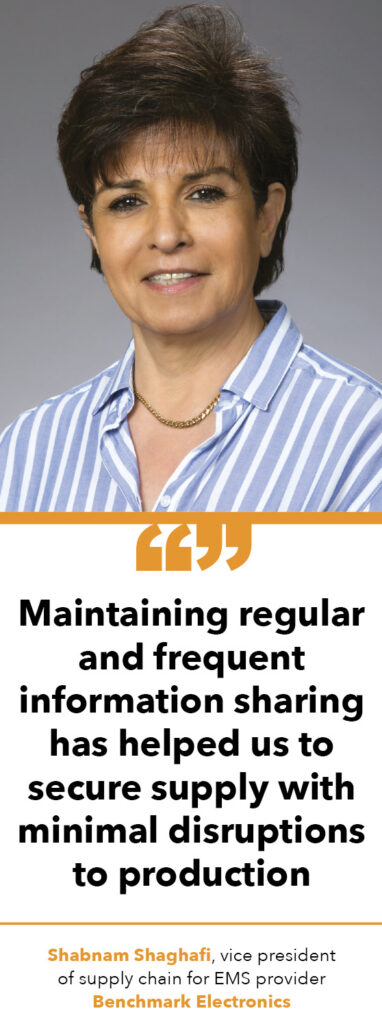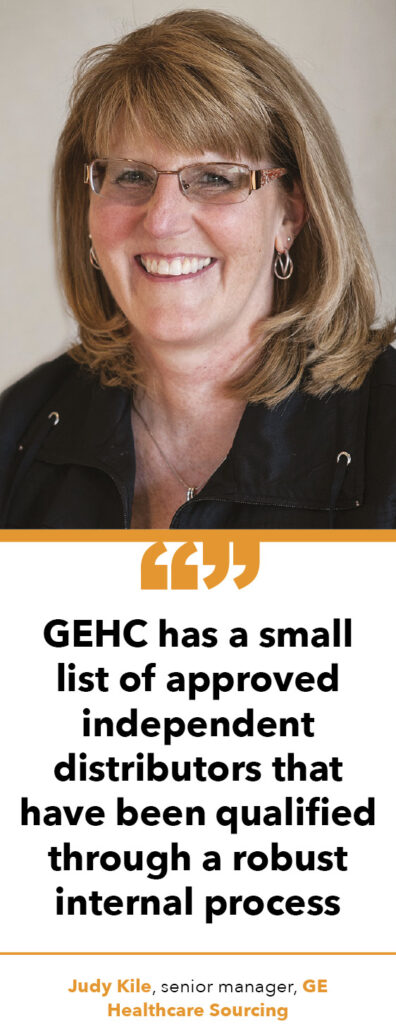
Buyers qualify new suppliers, share long-range forecasts and look to distributors for help in sourcing parts that are in short supply – by James Carbone.
By most accounts, supply of semiconductors and other components will be constrained through the first half of 2021 and buyers at OEMs and electronics manufacturing services providers are employing strategies and tactics to make sure their companies get all the parts needed to keep production lines running.
While most buyers like to have a limited number of suppliers, some are qualifying new suppliers for commodities and finding alternative parts for shortage components in an effort to maintain the supply for hard-to-find chips and passives. Others are buying parts from more authorized distributors and taking advantage of inventory programs that hold inventory of needed parts on behalf of customers until the components are needed for production.
Of course, many buyers are also returning to non-franchised, independent distributors, whose businesses thrive during component shortages because they either have the parts in stock or know where they can be sourced. While historically many buyers have been suspicious of independent distributors over quality and counterfeit concerns, some independent distributors have enhanced quality systems and screening processes in an effort to eliminate substandard or counterfeit parts from their inventories.
One part of having a strategic relationship with supplier is to provide long-term forecasts of component demand, especially when demand is rising and there’s a possibility of shortages. Some electronics industry executives have said that no forecast beyond 30 days can be accurate. However, forecasting techniques and tools have improved and forecasting demand has gotten better. Some suppliers say any forecast is better than no forecast, especially if it is updated frequently.
“We need to make sure we are providing our supply base with enough forecast to enable them to manage their supply chain,” said Graham Scott, vice president of procurement for EMS provider Jabil Inc., based in St. Petersburg, Fla. “We really need to be providing them with as much as 12-months’ worth of forecast.”
 Forecast sharing
Forecast sharing
He said it is also important that Jabil’s customers share their long-term forecasts with the EMS provider because it impacts Jabil’s semiconductor forecasts to chipmakers and passives manufacturers. “We share that information with our suppliers as quickly as possible,” he said. “The more visibility we give to suppliers, the better chance we have of ensuring the products our customers require can be built on time.”
Such forecasting sharing is always important, but more so when demand is increasing and there is not enough component production capacity to go around. Scott says that was the case in 2020 when COVID-19 slowed or shut down production at many electronics manufacturers. However, component demand is bouncing back in early 2021 and demand is starting to outstrip supply for some parts.
In fact, Jabil saw some of the industries that “lagged because of the virus started to bounce back” in the second half of last year. “We saw automotive, industrial, the consumer markets all come back with strong demand.” said Scott. In addition, more 5G smart phones are starting to ship which is adding to component demand.
As a result, “we are faced with many constraints right now with semiconductors made on 8-inch wafers,” said Scott. Fabs using 8-inch wafers are struggling to keep up with demand. “They are running at 100 per cent capacity,” said Scott. With 12-inch fabs, there’s a “little bit more leeway there but they are constrained, too, and that’s leading to a lack of flexibility in the markets,” he said.
Lack of flexibility means a wide range of components were constrained in the first quarter, including microcontrollers from NXP and STMicroelectronics, NXP transceivers, Maxim discretes, Realtek digital audio converters and various chips from ON Semiconductor and Infineon.
“Resurgent demand, combined with tight capacity at fabs and shortages of raw materials like wafers and substrates” is making it challenging for semiconductor manufacturers to produce all the parts for all customers, said Luke LeSaffre, director of sales-Americas for independent distributor Fusion Americas.
“The volume and size of requirements we have received are strong but the amount of product available to support is not very high,” he said. “We are entering this market from a period when activity levels were low, as compared to 2018 when that market was the culmination of many years of strong demand building over time,” said LeSaffre. He added the pervasiveness of shortages is “leading to more line stoppages.”
 Keep suppliers close
Keep suppliers close
Some electronics purchasers say the key to managing shortages and to prevent line shutdowns is to make sure your company has close strategic relationships with critical suppliers before shortages occur. After shortages hit, it may be too late.
The best approach to combatting potential impact of shortages is to “have a consistent nurturing of strategic relationships with your key suppliers,” according to Jamey Mann, director of global purchasing at electronics manufacturing services (EMS) provider Kimball Electronics, based in Jasper, Ind. ”A shortage driven market is not the time to try to begin a strategic relationship. This should be ongoing,” he said.
When a company has close relationships with key suppliers, there is going to be ongoing communication with those suppliers and market indicators will be monitored and shared. “This allows us to make strategic decisions of when to flex order horizons and supply programs to enable mitigation of near and long-term impacts,” he said.
It may not absolutely guarantee supply but having established, strategically placed relationships, coupled with “open and honest communications with suppliers and customers, delivers confidence that the supply chain will sustain our operational support of our customer,” said Mann.
Relationships are essential
Shabnam Shaghafi, vice president of supply chain for EMS provider Benchmark Electronics, based in Tempe, Ariz., said that “developing strategic relationships with key suppliers is an essential part of our business.”
“Maintaining regular and frequent information sharing has helped us to secure supply with minimal disruptions to production,” she said. Benchmark’s strategic partners “offer excellent service. Through collaboration and communication with our suppliers, and customers as needed, we have been able to secure supply and overcome challenges in a constrained market,” she said.
The relationships Benchmark has had with key suppliers is helping it weather the impact to last October’s fire at Asahi Kasei Microsystems factory in Japan, which knocked out production of DAC and ADC chips and other materials for at least six months.
When production of parts is disrupted by a catastrophic event, Benchmark minimizes the impact by implementing “various proactive measures to help us overcome supply assurance issues.” For instance, Benchmark has a “robust and diversified supply base where we can easily identify backup/alternative suppliers in many cases,” said Shaghafi. “Additionally, we are able to bridge supply gaps by nimbly evaluating critical components of the supply chain and offering alternative solutions to our customers,” she said.
If an alternative requires redesign, Benchmark can offer rapid solutions to customers for their “evaluation of overall compatibility and product performance to ensure form, fit, and function of the product.”
Judy Kile, senior manager, GE Healthcare Sourcing, based in Chicago, says it is not common to re-design a board specifically for shortages due to the stringent quality requirements and time required for a re-design.” She said GEHC buyers proactively work to have multiple sources identified for a commodity. “In the case where there is a form, fit, functional equivalent, we have processes in place to cross functionally evaluate and quickly add to a BOM,” said Kile.
Identifying alternate components is also important to Kimball and its customers.
“We work diligently to identify and suggest alternate components for our customers to qualify in order to de-risk the supply,” said Mann. He noted Kimball’s customers own the designs of the products Kimball builds, so it is their decision “to make as to which suggestions are acceptable in their designs.” He notes Kimball builds highly reliable, durable assemblies for its OEMs, “so in most cases there are regulatory compliance hurdles to clear before alternates can be consumed in their products.”
 Working with distributors
Working with distributors
Most OEMs and EMS providers work with distributors to help manage shortages. “We have several programs in place with our key strategic distributors to secure supply and support our customer requirements,” said Shaghafi. Catalog distributors offer “us some leverage and the ability to purchase larger volumes to fill supply gaps as needed,” she said.
Catalog distributors are also important to Kimball Electronics. “Key distributors in this area of focus have expanded their abilities to more than just supplying engineering volumes” said Mann. “Both gap and everyday demand fulfillment from these partners bolsters our ability to cover the needs of our customers.”
Mann added that it has strategic relationships with several distribution partners that are “instrumental in maintaining continuity of supply” at Kimball. “These partners and their ability to manage supply are a key component of our supply chain strategy,” he said.
Kimball also uses a “strategic set of independent distributors for shortage components and end-of-life parts,” said Mann. “They must continue to meet our stringent requirements of part authentication as part of our anti-counterfeit processes,” he said.
Benchmark also uses independent distributors for hard-to-find parts despite the risk, said Shaghafi.
Non-franchised distributors “can be helpful in circumstances of small and niche needs. Their flexibility and ability to navigate through unique sourcing channels offers sufficient opportunities to bridge immediate or small and short-term needs,” she said.
However, that flexibility comes with risk. She said Benchmark needs to “assure a chain of custody, material viability, and accurate labeling associated with counterfeiting or adulterated material.” The EMS provider requires suppliers to provide documents with every shipment. Shaghafi added Benchmark has a “rigorous qualification process for non-franchised distributors.”
She said Benchmark has close relationships with a few independent distributors and we “audit their systems periodically, and address many of our risk elements proactively.”
Medical OEM GEHC also uses a small list of approved independent distributors that have been qualified through a “robust internal process,” according to Kile. Independent distributors must meet GEHC’s stringent quality, testing and traceability requirements. “Each of the distributors stand 100 per cent behind the products they deliver for us. They have been extremely helpful with shortages, particularly over the past 10 months,” said Kile.
Scott said during times of shortages it is important to stay close to suppliers. “We need to understand what is driving the market” which suppliers, including component manufacturers and distributors, can help with. In addition, suppliers can provide information concerning new regulations and the “impact they can have on our supply base,” said Scott.
Commodity managers sourcing parts must factor in new technologies and components that are being introduced when they make sourcing solutions to avoid the risk of shortages. Supply of parts made with new technologies is often limited.
“We have to make sure we are using the appropriate supply base for a new technology,” said Scott. “We need to make sure commodity management get involved with those conversations to ensure that we have a supply chain that’s going to be robust enough for a product launch,” he said.
